|
A
special thank you to Lynne M. Barrelle, Grove Foote, Jack
Sanders, John Sturges, John Robie and many others from around
the World that have forwarded these images to me. A complete
history of the Gilbert & Bennett Manufacturing Co. in
pictures is a wonderful addition to the site.
Note
dial-up users: should the images take too long to load and
some pictures come up with an "X" hit refresh in
the your browser. I'm breaking up these pictures to keep downloads
to a minimum- 181 years of history is a bit too much for one
page.
Have
pictures you'd like to include? Email them to bcolley@snet.net
or call me at 860-364-7475, I can scan the images if you'd
like and get them right back to you in less than a week.
Sponsor
Link:
Norwalk
River Watershed Assoc.
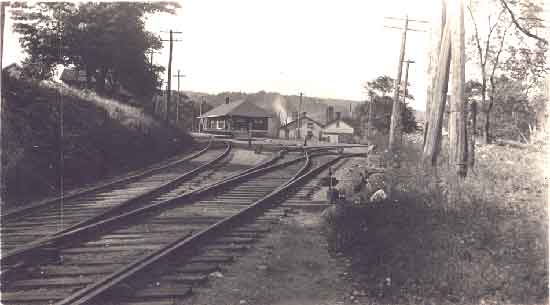
The decisions that
were made in rebuilding the properties insured Gilbert and
Bennett's success for generations to come. One of those decisions
was to lobby the Danbury and Norwalk Railroad to run a line
into the mill.
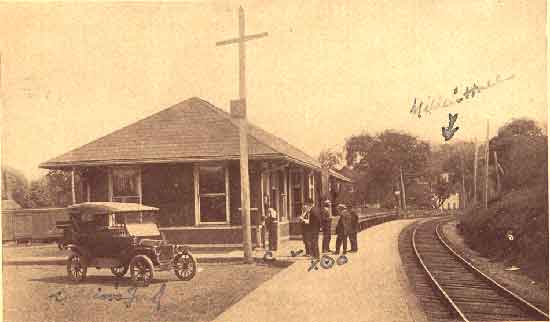
The Danbury and
Norwalk Railroad traveled through Georgetown as early as 1852,
but it was during the 1874 reconstruction that the railroad
was convinced to run a spur line into the mill property. The
track that came into the mill, branched off from the railway
just before the Georgetown Train Station where Miller Hall
stood, two team tracks split to the left, one lead to the
back of Georgetown Station and the other extended further
to the road.
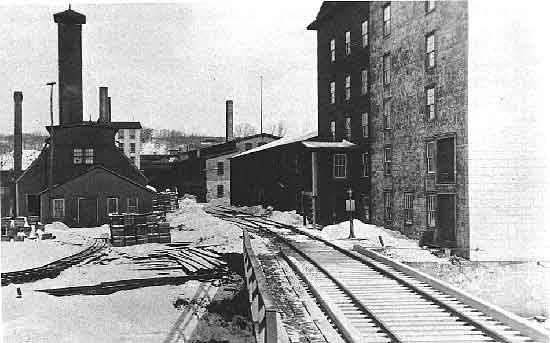
The main track
split in two, where it joining again in the factory. In addition
to Miller's Hall, two small sheds also stood, one of which
was a coal shed. The spur lines enabled the company to ship
and receive material more efficiently, and reduce the manpower
required in the process.
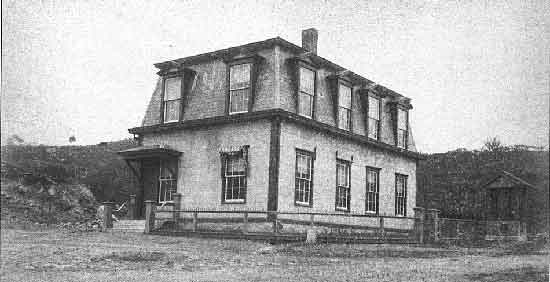
In 1875 a corporate
office was constructed on the upper factory property. The
corporate headquarters building was a novelty in construction-
the framework inside and out is stapled wire cloth (called
wire lathing) in place of the usual wood lathing and sheathing.
On the outside is laid cement made to imitate stone and on
the inside is the usual plaster. They noted- "this style of
construction is not only a novelty but a perfect success"
in their "Wire Wonders" publication of 1893.
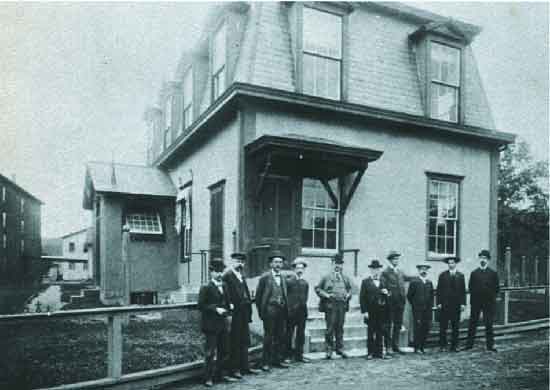
An interesting side
note to this building location is that when the Gilbert &
Bennett Co bought of Timothy Wakeman his sawmill, with the
mill rights and land in 1848, they also bought the old Baptist
church, remodeling it into a dwelling. In 1875, the old church
was torn down to make room for new buildings. Historian Wilbur
F. Thompson assisted in the remodeling. Thompson notes that:
some of the timbers were found to be shattered by the explosion
of 1838.
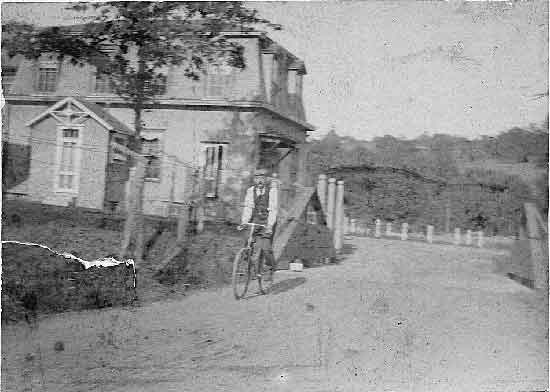
In the old Baptist
church record we find the following statements regarding the
explosion: "Nov. 26, 1838, the Rev. Nathaniel Colver lectured
in our meeting house on slavery (against it), and was disturbed
by unruly persons: Nov. 27, 1836, another lecture, disturbed
as before; Nov. 28, 1838, our meeting house blown up but not
entirely destroyed. The Old Gilbert & Bennett Mfg. Co. office
stood on the site of the old church, and great factory buildings
cover the old church lot.
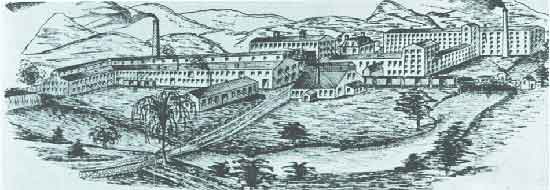
At this time what
we know today as North Main Street did not run around the
factory, it came straight through it. The Old Corporate Headquarters
we just viewed in the above pictures is top center in this
drawing.
On May 10, 1889
the Old Red Mill was destroyed by fire and a new mill was
built in its place. The Red Mill was being used strictly for
the drawing of fine wire, tinning and galvanizing wire in
its later years.
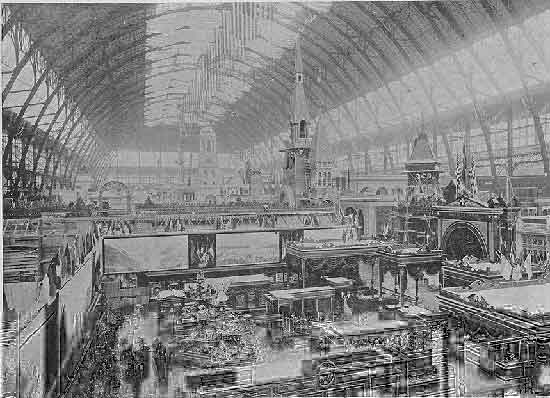
Gilbert & Bennett
celebrated its first 75 years at the 1893 World's Fair in
Chicago, in which the company was an exhibitor. The company
supplied 3 miles of woven fencing, which enclosed the fair's
railroad platforms, and about 8 acres of netting (shown above),
which hung under the fair buildings' glass ceiling to prevent
shattered glass from falling on people. At this World Fair
the company exhibited: Gold, Silver, Aluminum, Brass, Copper,
Galvanized and "Pearl Wire Cloth, Galvanized Netting, Wire
Fencing, Gates, Ornamental Wire Work, G&B's system of Fireproofing,
Stable fixtures, Screens, Home Furnishing Wire Goods, and
a sample of the 1st netting made by power machinery and exposed
to the open air for 25 years.

Dam of the upper
factory pond. 300 were employed by G&B- 175 at the Georgetown
mills (representing 20% of the wire industry workers in Connecticut),
75 at the Chicago factory and the remainder belonging to the
selling and clerical force in 1893. By 1906, the company had
grown to employ 600 workers.
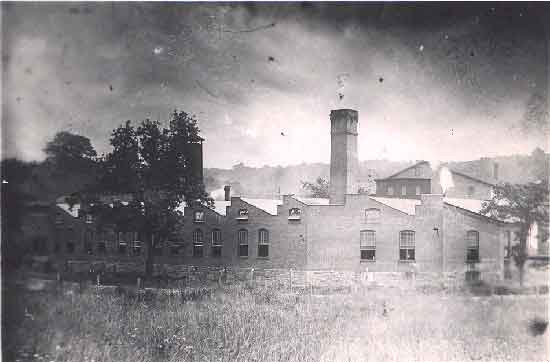
Sawtooth Factory
about 1900. We know this is an early picture as there are
no banners on the building.
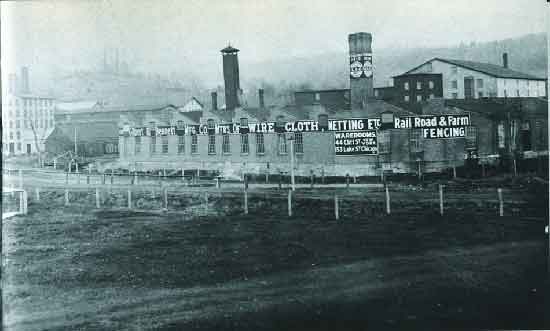
View of the Sawtooth
factory with the banners. This picture was taken from about
where the old G&B post office is today on North Main Street.
In this picture we see a new road way coming around the factory
building as it does today. The road through the factory was
still in use as we can see the bridge on the left.
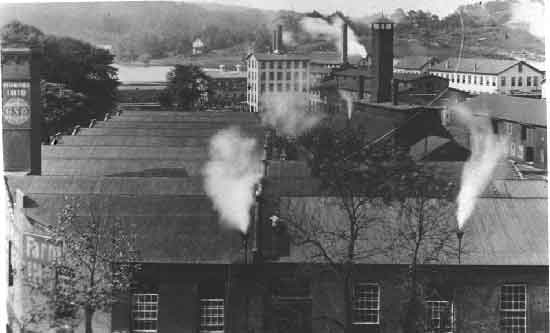
View of Portland
Avenue sometime between 1900 and 1906. This picture shows
only one house on Portland Avenue that was likely a tenement
house for workers. The rest of Portland Avenue was not developed
until the 1920's.

View of the New
Corporate Headquarters Building- completed in 1906 . In 1906,
Edwin Gilbert, son of the founder, died at his vacation home
in Crescent City, Florida on February 28th. As a salesman,
director, treasurer, and president of the company, he served
the company for 62 years. His estate was valued at over one-half
million dollars, half of which he left to the community.
In
the next section we will showcase the "Miller
Era" 1906-1954.
John
Moore Collection; Tryde
Photo's ; Redding
Times Photo's ; Tour
Present Day Georgetown ; Brent
Colley Collection
Back
to TOP | Back to Redding
Section | Back to Georgetown
Section
|

